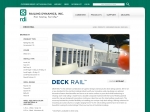Decking Materials
There is a wide variety of deck materials on the market today. The material you choose tells us a lot about your style preferences. It is important to keep in mind the style, color, and maintenance required for your material choice. While wood decking presents a beautiful, natural look, it also has to be stained at least once a year in order to protect the lumber from weathering. Many of the composite decking products we offer provide a similar look, with less maintenance and no staining. If you are unsure which material best fits your needs, please contact us for a full overview of our product offerings.
Below is a list of the materials we currently use in our projects and our recommendations for each:
Pressure Treated
 Pressure treated deck boards are the least expensive option for your deck. This selection is one that will require extra maintenance but maintains a natural feel for your outdoor space. Treated lumber is a real wood that has been cured with chemicals to resist decay, fungi, mold, and withstand the elements. Treated decking comes in two different grades, #1 and #2. Decking receives the Number 2 grade when increased imperfections in the boards. The grader holds these boards to a lower standard upon visual inspection which results in a lower price. Lumber receiving a Number 1 grade is the board we always recommend for clients who choose a pressure treated deck. The difference is typically based on the visual appearance of the knots in the wood. Number 1 treated lumber will have fewer and much tighter knots creating a far superior board.
Pressure treated deck boards are the least expensive option for your deck. This selection is one that will require extra maintenance but maintains a natural feel for your outdoor space. Treated lumber is a real wood that has been cured with chemicals to resist decay, fungi, mold, and withstand the elements. Treated decking comes in two different grades, #1 and #2. Decking receives the Number 2 grade when increased imperfections in the boards. The grader holds these boards to a lower standard upon visual inspection which results in a lower price. Lumber receiving a Number 1 grade is the board we always recommend for clients who choose a pressure treated deck. The difference is typically based on the visual appearance of the knots in the wood. Number 1 treated lumber will have fewer and much tighter knots creating a far superior board.
Cedar
 A step up from pressure treated lumber is cedar decking. Cedar is an beautiful wood that we recommend over a pressure treated board. It is a softwood which makes it extremely easy to cut and work with allowing a builder to produce an amazing product. It is a terrific choice in building railings, steps, benches, pergolas, trellis, or planter boxes. Cedar is naturally resistant to decay, mold, and fungi, however we always encourage our customers to seal and stain their cedar deck as an extra precaution to preserve its life. On average you should re-seal your cedar deck every 3-5 years. Cedar is available in (4) different grades that range from a standard cedar board from your local Home Depot to a clear grade cedar from a lumber yard. Pricing on the lowest grade cedar matches up closely to the best grade treated lumber; while a clear grade cedar is a beautiful decking board and can cost more than some composite boards.
A step up from pressure treated lumber is cedar decking. Cedar is an beautiful wood that we recommend over a pressure treated board. It is a softwood which makes it extremely easy to cut and work with allowing a builder to produce an amazing product. It is a terrific choice in building railings, steps, benches, pergolas, trellis, or planter boxes. Cedar is naturally resistant to decay, mold, and fungi, however we always encourage our customers to seal and stain their cedar deck as an extra precaution to preserve its life. On average you should re-seal your cedar deck every 3-5 years. Cedar is available in (4) different grades that range from a standard cedar board from your local Home Depot to a clear grade cedar from a lumber yard. Pricing on the lowest grade cedar matches up closely to the best grade treated lumber; while a clear grade cedar is a beautiful decking board and can cost more than some composite boards.
Composite
 Who doesn’t want a “maintenance free” deck? Often sold using this term, composite boards are not entirely maintenance free. The composite products we provide have a PVC surface, many containing composite core manufactured using recycled materials for the eco-friendly customer. Other composites we offer are PVC throughout. Most customer’s base their choice on the color, design and price of each. While, these products do not require annual staining and so they are certainly less maintenance than pressure treated decking, you should power wash your composite deck at the beginning of each season to remove debris accumulated through the fall/winter.
Who doesn’t want a “maintenance free” deck? Often sold using this term, composite boards are not entirely maintenance free. The composite products we provide have a PVC surface, many containing composite core manufactured using recycled materials for the eco-friendly customer. Other composites we offer are PVC throughout. Most customer’s base their choice on the color, design and price of each. While, these products do not require annual staining and so they are certainly less maintenance than pressure treated decking, you should power wash your composite deck at the beginning of each season to remove debris accumulated through the fall/winter.
Exotic Woods
 Another decking option, growing in popularity is exotic woods. Customers can choose from woods such as Ipe, Mahogany, or Cumaru. If you have the time, energy, or money to keep these decks maintained throughout their lifetime your deck will be the talk of the neighborhood. These exotic woods, unlike cedar are very dense and are considered to be hardwoods not softwoods. All three naturally resists decay, mold, water or fungi. They have a gorgeous clear finish. However, over the course of time they do tend to “weather” in their own distinct way. For example, an unfinished Ipe board will weather to a grey-ish “antique” color. This is not a bad thing as even in its natural way of weathering, Ipe is desired by many of our clients. As with all real wood decking, we advise our customers to seal the decking as an extra precaution protecting the wood from the elements. To obtain their amazing look, you should keep in mind that you resealing or re-staining every 4-5 years is recommended. Each of these exotic wood choices is extremely durable. While their initial cost can be expensive you can expect to obtain at least 25 years of life out these boards.
Another decking option, growing in popularity is exotic woods. Customers can choose from woods such as Ipe, Mahogany, or Cumaru. If you have the time, energy, or money to keep these decks maintained throughout their lifetime your deck will be the talk of the neighborhood. These exotic woods, unlike cedar are very dense and are considered to be hardwoods not softwoods. All three naturally resists decay, mold, water or fungi. They have a gorgeous clear finish. However, over the course of time they do tend to “weather” in their own distinct way. For example, an unfinished Ipe board will weather to a grey-ish “antique” color. This is not a bad thing as even in its natural way of weathering, Ipe is desired by many of our clients. As with all real wood decking, we advise our customers to seal the decking as an extra precaution protecting the wood from the elements. To obtain their amazing look, you should keep in mind that you resealing or re-staining every 4-5 years is recommended. Each of these exotic wood choices is extremely durable. While their initial cost can be expensive you can expect to obtain at least 25 years of life out these boards.

 Contact Us
Contact Us

















